Ishuretsuzo, the Image of Ezo: Tracing Persons, Things and the World | Exhibition Guide

Exhibition Guide
Chapter 1 Genealogy of Ishuretsuzo Works
The Ishuretsuzo series of portraits depicting 12 Ainu chieftains was painted in 1790 by Hakyo Kakizaki (1764 ‒ 1826, also simply known as Hakyo) ‒ a retainer and later a chief retainer of the Matsumae Clan. The chieftains are considered to have collaborated with the Matsumae Clan in ending the Kunashiri-Menashi Battle of 1789 (an attack of Ainu people against Japanese rulers and merchants). To mark their achievements, Hakyo painted the 12 portraits under the orders of the lord of the Matsumae Clan. The following year, the paintings were taken to Kyoto, where they were well received and came to the attention of Emperor Kokaku. A number of reproductions were subsequently created by lords of various feudal clans (known as daimyo). This exhibition highlights the Ishuretsuzo collection’s true appeal with paintings brought together from around the world for the first time. Works include original paintings held by the Besançon Museum of Fine Arts and Archaeology, reproductions created before the Meiji period, and sketches and faithful copies believed to have been created by Hakyo himself.
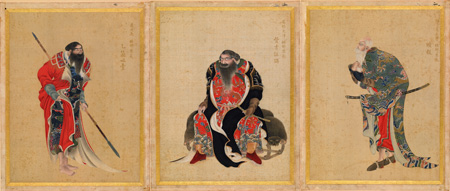 |
|
Ishuretsuzo by Hakyo Kakizaki (Besançon Museum of Fine Arts and Archaeology Collection in France) |
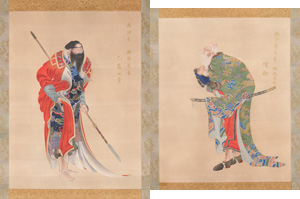 |
|
Onmikata Ezonozu attributed to Hakyo Kakizaki (Hakodate City Central Library Collection) |
Chapter 2 Individuals and the Ishuretsuzo Collection
The 12 Ainu chieftains depicted in the Ishuretsuzo collection fascinated noblemen, literati and statesmen with their extraordinary yet dignified appearance. Hakyo Kakizaki created the images using a variety of elements particular to contemporary pictorial art, such as: the style of Chinese painter Shin Nanpin (the founder of the Nanpin school) ‒ a popular technique that Hakyo learned in Edo; the expressive style of Western paintings, which had just been introduced to Japan; the postures of hermits depicted in illustrated catalogs, which were much talked about; and the formats used in portraits of meritorious Chinese retainers. The exhibition will highlight these elements through the works of notable painters of the time, including the monk Gessen and Shiseki So, under whom Hakyo studied. Behind the Ishuretsuzo collection was a network of people with surprising interconnections. These included the aforementioned painters, Emperor Kokaku (who actually saw the Ishuretsuzo collection) and other nobles, writers such as Kien Minagawa and Zenji Daiten, powerful feudal lords (known as daimyo) such as Seizan Matsura and Sadanobu Matsudaira (who ordered the reproduction of the Ishuretsuzo collection), and the daimyo painters who actually reproduced the works. The exhibition will trace such connections to the Ishuretsuzo collection through paintings.
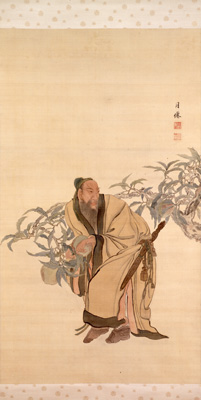 |
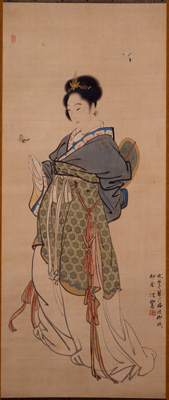 |
|
Tohosakuzu by the monk Gessen (Mie Prefectural Art Museum Collection) |
To Bijinzu by Hakyo Kakizaki (Hakodate City Museum Collection) |
Chapter 3 Items and the Ishuretsuzo Collection
The tools featured in the Ishuretsuzo collection play an important role in giving the 12 Ainu chieftains their extraordinary yet dignified appearance. Ezo Nishiki garments were expensive imports from China, and the depiction of the 12 Ainu leaders wearing them gives them the air of foreigners of high standing. Korean wool tapestry, Batik fabric from Java and other high-grade imported fabrics are also depicted in the works. Powerful feudal lords (known as daimyo) and members of the literati highly valued the tools held by the Ainu leaders for their rarity. The coats worn by Tsukinoe and Ikotoi and the shoes worn by several Ainu leaders are evocative of the West (particularly Russia, with which Ezochi had connections). The clothes and tools depicted in the collection indicate that cultural products were exchanged with other parts of Northeast Asia, and suggest demand for cultural products from overseas among the Wajin.
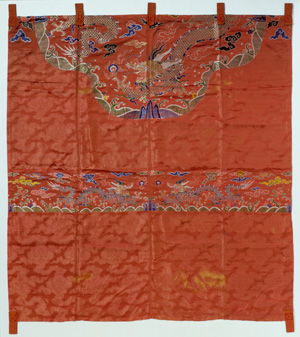 |
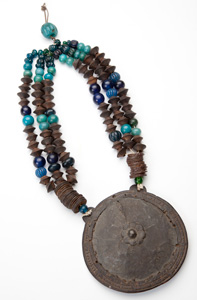 |
|
Screen made of Ezo nishiki (akaji mouhou) fabric (National Museum of Japanese History Collection) |
Necklace designated as a National Important Tangible Folk Cultural Property (Hakodate City Museum Collection) |
Chapter 4 The World and the Ishuretsuzo Collection
In the early 18th century, Ezo was featured in Wakan Sansai Zue (an illustrated encyclopedia compiled by Ryoan Terajima in the Edo period). Subsequent illustrations stimulated the curiosity of people in Honshu and areas farther south by giving them a glimpse of the conditions of Ezochi and Ainu people. At the end of the 18th century when the Ishuretsuzo collection was painted, this curiosity extended from Ezochi to parts of the outside world such as Russia, whose territory was approaching that of Ezochi. The exhibition will highlight how the Wajin viewed the world from the 18th century to the 19th century through pictures and maps. These views shaped the Ishuretsuzo collection, and interpretations of the collection have in turn shaped new views on the world. The perspectives to be presented by this exhibition, which highlight these intersecting views, help to shape people’s take on the world today.
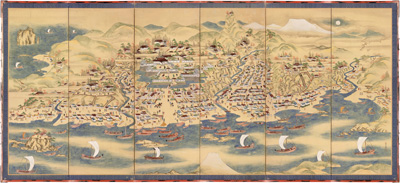 |
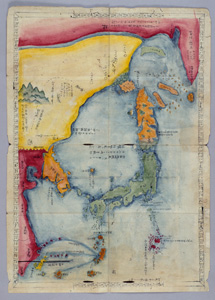 |
|
Matsumae Byobu by Teiryo Kodama (Matsumae Town Board of Education Collection) |
(Original) Sangoku Tsuranzusetsu Sangoku Tsurannozu by Shihei Hayashi (Copy) (National Museum of Japanese History Collection) |





